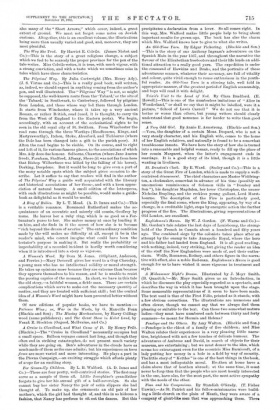The Pilgrims' Way. By Julia Cartwright (Mrs. Henry Ady). (J.
S. Virtue and Co.)—This is a really good book, well written, as, indeed, we should expect in anything coming from the author's pen, and well illustrated. The " Pilgrims' Way " is not, as might be supposed, the well-known route from the Tabard,' or the site of the Tabard,' in Southwark, to Canterbury, followed by pilgrims from London, and those whose way led them through London. It starts from Winchester, where it takes up a very ancient Roman, or rather British, road (used, it is thought, to carry tin from the West of England to the Eastern ports). We begin, accordingly, with an account of the ecclesiastical sights to be seen in the old royal city of St. Swithun. From Winchester the road runs through the three Worthys (Headbourne, Kings, and Martyrsworthy), Itchen, Stoke, Alresford, and Tichborne (where the Dole has been changed into a gift to the parish poor). At Alton the road begins to be visible. On its course, and to right and left of it, lie various famous places, to the associations of which Mrs. Ady does due honour. Selborne, Chawton (where Jane Austen lived), Farnham, Shalford, Albany, Shere (it was not far from here that Bishop Wilberforce was killed by the falling of his horse), Dorking, Deepdene. But it would be long to give even a part of the many notable spots which the subject gives occasion to de- scribe. Let it suffice to say that readers will find in the author of The Pilgrims' Way a guide well acquainted with the literary and historical associations of her theme, and with a keen appre- ciation of natural beauty. A small edition of the letterpress, with such illustrations as might be possible, would make a guide- book as delightful as it would be useful.


















































 Previous page
Previous page